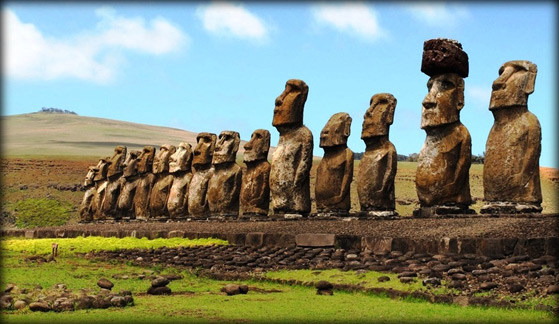The mysterious Moai of Rapa Nui
By Amal Hewavissenti
Dutch explorer Jacob Rogevn the first European to have disembarked on
the island of "Rapa Nui" was greatly amazed at the massive stone statues
planted on the different points of its treeless coast. Jacob Rogevn and
his explorer team named the island "Easter Island of the Pacific Ocean"
but they remained in total wonderment as to what giant hand could have
erected the statues with the help of logs on the apparently treeless
stretch of the island.
The current inhabitants of the island who speak Polynesian language
have directly descended from a group of Polynesian people who discovered
the Rapa Nua island in 900 AD. Geologically the island is an obvious
offshoot of an undersea volcanic eruption which might have occurred
around three million years ago.
What baffles the mind of the current visitor is the mystery as to who
created the Moai Statues, who inhabited the island for the first time,
what happened to them and what technology they used to create the
statues and to erect them. The island of Rapa Nui has earned a
widespread fame fairly because of these mystery statues which range from
five feet to about thirty feet in height.
|

Moais with full bodies visible at Ahu Tongariki. |
These Moai Statues are invariably an impressive mystery and the
island it self appears to be an entire mystery. Even the eminent
researchers have failed to decipher the message conveyed by the
pictorial symbols on the "Rongo Rongo" tablets discovered in the caves
in the interior of the island. Many artefacts including stone carvings,
wood carvings and fragments of skeletons have been uncovered from the
caves which bear all marks of being inhabited by generations of people.
Reconstructing the story of Rapu Nui people and the island has become
a tremendously uphill task but the genre of Moai Statues has been
identified to be akin to that of Inca or Tahiti art. Easter island
Statues have been declared and preserved to be a world heritage by
UNESCO.
Unique site
Rapa Nui or the Easter island occupies a greater degree of
archaeological value. Only the huge granite heads and stone pillars
stand to represent the graceful civilisation of the past which too is a
mystery of time. A study team headed by Thor Heirdhal concludes that the
earliest Rapa Nui inhabitants have used stone from "Rano Raraku" (an
inactive volcano) to create the statues.
The study team have based their conclusions on the uncompleted
statues found inside and around "Rano Raraku". Heirdhal believes that
the platforms on which the statues have been placed, have served as
altars ( Ahu ) for devotees who performed religious rites. He further
says that Rapa Nui inhabitants probably raised these statues in
commemoration of their heroes or forefathers.
In spite of the absence of enormous trees in the island, it is
believed that the island had been a perfect habitat natural for the
growth of tall palm trees in the past. The earliest inhabitants must
have utilised these giant trees to build up canoes and to raise the
statues to how they appear to day. Yet none of these trees are to be
found on the island today.
William Hodges, a British painter visited the Easter island (Rapa Nui)
in 1770 and depicted the wholly ruined city in a painting. The painting
showed that the once respondent Rapa Nui city and civilisation had been
reduced to a heap of rubble on account of the very activities of the
same people who had created it. The painting showed the few stone
pillars, statues and the treeless stretch of land.
Scholars point out that excessive cutting of palm trees and other
tall trees subsequently resulted in the destruction of forest coverage
and the civilisation itself. It is said that an enormous amount of trees
had to be felled in order to construct and transport these gigantic
stone statues. The glorious civilisation of Rapa Nua people had died
owing to deforestation, the increase of population, and perhaps foreign
invasions.
The secret of the hat
A strange feature of some of the massive Moai statues is the reddish
stone hat which has been placed later on the head. It is clear that
these clear cut hats have not been carved with the head and the variety
of the stone of the hat varies from the rest of the stature. A team of
British archaeologists who probed deep into how the hats were made and
placed on the heads discovered a small foot path which led to an ancient
volcanic cavity.
They discovered, in this cavity, a stone quarry where the Rapa Nui
people had probably created the "red hats". The red hats produced in
this volcanic cavity were transported on logs to where the statues were
located. The hats had been produced out of red iron ore (condensed lava)
in the cavity of the inactive volcano. The surprise is how these huge
stone hats (several tons in weight) could have lifted up to the thirty
feet high Moai Statues. If will be really an eternal puzzle for the
mankind.
The Easter island now belongs to the state of Chilie and is occupied
by a Polynesian people who speak a Tahiti dialect.
The novel Chariots of Gods written by Eric von Danicane says that the
Moai statues were created by some aliens who had been trapped in the
island. The novel further says that these trapped aliens were later
rescued and taken back to their planets. However, this is pure
imagination. |

